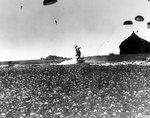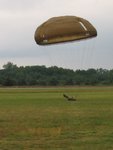Navigation
Install the app
How to install the app on iOS
Follow along with the video below to see how to install our site as a web app on your home screen.
Note: This feature may not be available in some browsers.
More options
You are using an out of date browser. It may not display this or other websites correctly.
You should upgrade or use an alternative browser.
You should upgrade or use an alternative browser.
Strange pic
- Thread starter VALENGO
- Start date
Ad: This forum contains affiliate links to products on Amazon and eBay. More information in Terms and rules
More options
Who Replied?davparlr
Senior Master Sergeant
Looks like a German paratrooper landing head first in a poppy field in East Europe somewhere, probably Soviet Union.
- Thread starter
- #3
VALENGO
Senior Airman
Yes, the shack at foreground looks like an isba.
mikewint
Captain
pretty hard to land head first unless you lost the chute or your feet get tangled in the risers. details are difficult to make out but it looks like a strong ground wind kept the chute inflated dragging him (dust cloud) along the ground head first. there appears to be something sticking out of the ground that he then struck with his head, his momentum then his feet came up and over, kinda like a sport bike doing a "stoppie"
- Thread starter
- #5
VALENGO
Senior Airman
Did he crashed with head against some obstacle?. Now that you point it, looks like there was something in the head´s trajectory.
Kingscoy
Senior Airman
It is actually quit right what the man does. If you are airborne, upon touchdown you make a so called para role. Apparently the photographer made his photo during this role. I have included a photo of my own airborne unit were the photo was taken just a fraction of a second later.
And I don't think it is a German paratrooper, looking at the four risers. The German parachute had their risers attached in a single point.
Cheers,
Sander
And I don't think it is a German paratrooper, looking at the four risers. The German parachute had their risers attached in a single point.
Cheers,
Sander
Attachments
Last edited:
mikewint
Captain
spent many happy hours learning the PLF but you end up on your back not head as in the pic. you can't see his head, there is something curved in the way. the dust behind him suggests he was being draggged by the chute at the time
Kingscoy
Senior Airman
spent many happy hours learning the PLF but you end up on your back not head as in the pic. you can't see his head, there is something curved in the way. the dust behind him suggests he was being draggged by the chute at the time
I have seen more of these, presumed head first, landing pics.There is even a RAF news reel regarding Market Garden showing a paratrooper landing the same way as this photo. Anyway if it is head first than he wasn't a happy fellow. But I don't think it is.
But the dust you mention....I looked at it, could it be that that's his reserve chute somehow deploying. It seems to me that it is so white to be dust.
Cheers,
Sander
Last edited:
I agree with Kingscoy, I think he just had a really bad role. But then again I never had the desire to go airborne. As a crew chief I had no desire to jump out of my perfectly good flying aircraft.
- Thread starter
- #10
VALENGO
Senior Airman
So, crash or para role?.
I agree about the dust, too white, perhaps another parachute.
I agree about the dust, too white, perhaps another parachute.
Colin1
Senior Master Sergeant
True enoughI agree with Kingscoy, I think he just had a really bad roll
it doesn't take much of a draught to get you going sideways quickly. All you can do then is rotate your chute and come in sideways to the line of travel with a fistful of lift web. Touchdown in these circumstances is rarely pretty.
Airframes
Benevolens Magister
I think this is a shot, possibly a 'still' from film footage, of British Paras (the canopies seem to be 'X' Type) in the 1950s, possibly in Greece, possibly the UK (Isba might be a hay stack).
The landing looks perfectly normal to me, and there is little wind, judging by the angles and oscillation of the other canopies. It looks like possibly his reserve has deployed, and it also seems he has landed on, or close to, at least two other canopies, or possibly the 'Alpha' marker on the DZ (would explain the location of the camera).
The para is half way through his PLF, with the canopy just beginning to collapse. The lift webs (risers) are still under tension, and the rigging lines are visible. He is not on his head, and there is no ground projection. What you are seeing is his left arm, still in the 'parachute position', with his shoulders rounded, and his chin on his chest, the standard position for landing. It also appears that the flaps of the back-pack, which enclose the static line bag when the 'chute is packed, are visible, partly obscuring his head. He will have walked away from that one without problem, the only criticism would have been from a P.J.I., that he didn't have feet and knees together !
The landing looks perfectly normal to me, and there is little wind, judging by the angles and oscillation of the other canopies. It looks like possibly his reserve has deployed, and it also seems he has landed on, or close to, at least two other canopies, or possibly the 'Alpha' marker on the DZ (would explain the location of the camera).
The para is half way through his PLF, with the canopy just beginning to collapse. The lift webs (risers) are still under tension, and the rigging lines are visible. He is not on his head, and there is no ground projection. What you are seeing is his left arm, still in the 'parachute position', with his shoulders rounded, and his chin on his chest, the standard position for landing. It also appears that the flaps of the back-pack, which enclose the static line bag when the 'chute is packed, are visible, partly obscuring his head. He will have walked away from that one without problem, the only criticism would have been from a P.J.I., that he didn't have feet and knees together !
Good shot of the 'landing' none the less, not something one would normally see though?
Kingscoy
Senior Airman
Good shot of the 'landing' none the less, not something one would normally see though?
Hmmm. Every landing I have made was like this. Especially backward landings with a few knots of wind. And like airframes said you walk away unharmed because if you don't execute your landing good you will be.
Cheers,
Sander
Airframes
Benevolens Magister
Agreed. Most people today are used to seeing 'stand up' landings on sport rigs, or might see film footage of military drops. In the latter, the roll is over before you can blink, so the attitude of the soldier on the deck is not noticed.
Know what you mean about the backward landings - if you walk away in one piece, it was a good one !!
Know what you mean about the backward landings - if you walk away in one piece, it was a good one !!
- Thread starter
- #16
VALENGO
Senior Airman
So, the normal landing in military jumps is backwards and not over the feet?.
Kingscoy
Senior Airman
You can land in every direction...frontal, rightside, leftside and backwards. That depends of your exit and is in limited ways changable. Backward landings are very disliked because you don't see that well were you are going giving a sence of not being in controll. It is difficult to explain...every landing is carried out using your role....feet and knees tightly together and full tension to the body. Upon touchdown you role in your "flight" direction because the chute will pull you there. And most of the times your role will be perfect and sometimes less perfect...or just bad beacuse of the wind speed, knees not together etc etc.
Cheers,
Sander
Cheers,
Sander
Last edited:
Airframes
Benevolens Magister
And the ground is invariably less than smooth and flat. Plus, your weapons container, hanging below you on a twelve foot (3.6m) rope, hits first, and can sometimes slightly 'arrest' the final part of your arrival, resulting in a landing resembling a dropped sack of potatoes (that's the polite description !).
The parachute canopy shown in Sander's landing is the current LLPC, a parachute designed for low level drops, and semi steerable. Previous canopies, such as the WW2 'X' type, and the later 'PXNS', used up until the late 1980's, are only semi-controllable by pulling down on the lift webs (risers) to spill air fom, for example, the rear of the canopy, partially decreasing forward drift, and likewise front and side drift. This only reduces forward movement by approximately 25%, so any wind at or over 10 knots is likely to introduce an 'interesting' landing !!
The parachute canopy shown in Sander's landing is the current LLPC, a parachute designed for low level drops, and semi steerable. Previous canopies, such as the WW2 'X' type, and the later 'PXNS', used up until the late 1980's, are only semi-controllable by pulling down on the lift webs (risers) to spill air fom, for example, the rear of the canopy, partially decreasing forward drift, and likewise front and side drift. This only reduces forward movement by approximately 25%, so any wind at or over 10 knots is likely to introduce an 'interesting' landing !!
never gave it a lot of thought before as the normal person would see straight forward sort of sanitised 'perfect' landings rather than what you are describing..Thanks for the info Guys...
- Thread starter
- #20
VALENGO
Senior Airman
We, civilians, are used to see those funny jumps with perfect landings on TV. Military jumps looks a little more rough. Why keeps still the parachute and is not used parapente (the flat one with mattress shape)?
Users who are viewing this thread
Total: 1 (members: 0, guests: 1)


